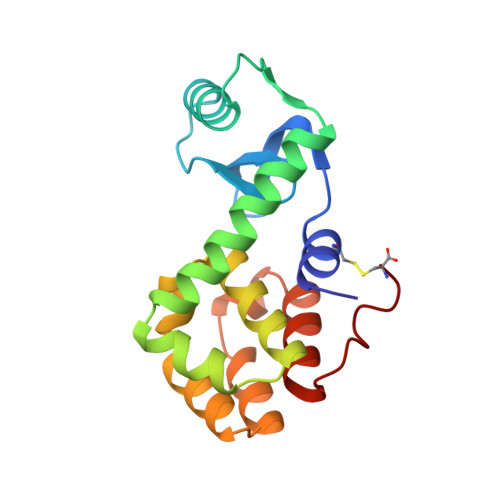Structure of a thermostable disulfide-bridge mutant of phage T4 lysozyme shows that an engineered cross-link in a flexible region does not increase the rigidity of the folded protein.
Pjura, P.E., Matsumura, M., Wozniak, J.A., Matthews, B.W.(1990) Biochemistry 29: 2592-2598
- PubMed: 2334683
- DOI: https://doi.org/10.1021/bi00462a023
- Primary Citation of Related Structures:
1L35 - PubMed Abstract:
A disulfide bond introduced between amino acid positions 9 and 164 in phage T4 lysozyme has been shown to significantly increase the stability of the enzyme toward thermal denaturation [Matsumura, M., Becktel, W.J., Levitt, M., & Matthews, B. W. (1989) Proc. Natl. Acad. Sci. U.S.A. 86, 6562-6566]. To elucidate the structural features of the engineered disulfide, the crystal structure of the disulfide mutant has been determined at 1.8-A resolution. Residue 9 lies in the N-terminal alpha-helix, while residue 164 is located at the extreme C terminus of T4 lysozyme, which is the most mobile part of the molecule. The refined structure shows that the formation of the disulfide bond is accompanied by relatively large (approximately 2.5 A) localized shifts in C-terminal main-chain atoms. Comparison of the geometry of the engineered disulfide with those of naturally observed disulfides in proteins shows that the engineered bridge adopts a left-handed spiral conformation with a typical set of dihedral angles and C alpha-C alpha distance. The geometry of the engineered disulfide suggests that it is slightly more strained than the disulfide of oxidized dithiothreitol but that the strain is within the range observed in naturally occurring disulfides. The wild-type and cross-linked lysozymes have very similar overall crystallographic temperature factors, indicating that the introduction of the disulfide bond does not impose rigidity on the folded protein structure. In particular, residues 162-164 retain high mobility in the mutant structure, consistent with the idea that stabilization of the protein is due to the effect of the disulfide cross-link on the unfolded rather than the folded state.(ABSTRACT TRUNCATED AT 250 WORDS)
Organizational Affiliation:
Institute of Molecular Biology and Department of Physics, University of Oregon, Eugene 97403.














